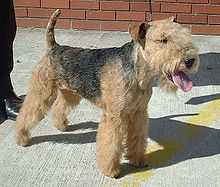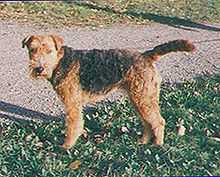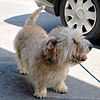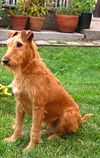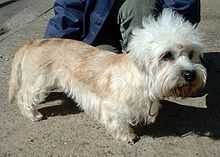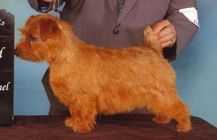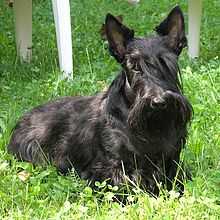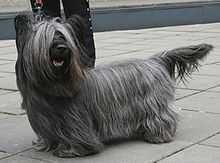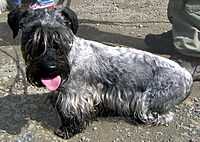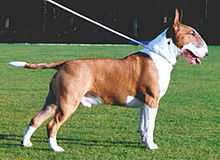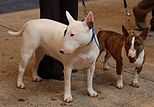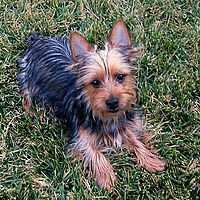Terrier Group
Terrier Group is the name of a breed Group of dogs, used by kennel clubs to classify a defined collection of dog breeds. In general, a Terrier Group includes one particular type of dog, the Terrier, although other types may be included in a kennel club's Terrier Group. Most major English-language kennel clubs include a Terrier Group although different kennel clubs may not include the same breeds in their Terrier Group. The international kennel club association, the Fédération Cynologique Internationale, includes Terriers in Group 3 Terrier, which is then further broken down into four Sections based on the type of terrier and breed history.
Terrier dogs
Terriers were originally kept to hunt vermin, especially mice, rats, rabbits, otters, stoats and weasels. Some Terriers were designed to go down the holes of the European fox and other agricultural pest animals in order to chase them out for the hunter, and the name terrier is from the Latin terra, meaning earth, in reference to the dogs going underground.[1] Today, the majority of modern breeds developed from the old terrier types are pets and companions. A few are still used as working terriers, and some terriers are large enough to be kept as guard dogs.
Terrier Group breeds
Kennel clubs assign breeds traditionally identified as terriers to their Terrier Group. Some kennel clubs prefer to use another category such as the Toy Group, Companion Group, Utility Group or Non-Sporting Group for certain terriers or terrier-like breeds, but most terriers are placed in the Terrier Group.
The United Kennel Club (US) is unusual in that it recognises Pinschers and Feists in its Terrier Group, along with other US breeds not recognised elsewhere. The United Kennel Club also lists the Hollandse Smoushond with the Terriers, which it resembles, but is elsewhere considered a Schnauzer-type breed. Another Schnauzer, the miniature Schnauzer (or Zwergschnauzer), is sometimes placed in a kennel club's Terrier Group. The Boston Terrier is usually listed by kennel clubs in the Companion Group or the Non-Sporting Group.
The American Kennel Club does recognize the Russell Terrier, although currently the breed is listed within the Foundation Stock Service (FSS) which is not categorized into the Terrier group.[2] Additionally, the United Kennel Club (UKC)changed the classifications of the different types of Russells starting in 2009. The Jack Russell Terrier prior to this time was really a Parson Russell Terrier (by AKC's standards) with an over 12" and under 12" breed types offered. The traditional Parson Russell Terriers were classified within the over 12" category while the traditional Jack Russell Terriers were classified within the under 12" category. The Russell Terrier, prior to 2009, included the shorter legged and longer backed variations of the breed. When the classifications were changed, the dogs within the Jack Russell Terrier breed that were over 12" tall at the withers were moved into the Parson Russell Terrier breed. Any dog in the Jack Russell Terrier breed at this time (within the UKC) may not be over 12" tall. The Russell Terrier breed has been blended into the Jack Russell Terrier breed within the UKC.[3]
Comparison of Terrier Group breeds of major kennel clubs
| The Kennel Club (UK) Terrier Group | Canadian Kennel Club Terrier Dogs Group | American Kennel Club Terrier Group | Australian National Kennel Council Terrier Dogs Group | New Zealand Kennel Club Terrier Group | United Kennel Club (US) Terrier Group |
|---|---|---|---|---|---|
| Airedale Terrier | Airedale Terrier | Airedale Terrier | Airedale Terrier | Airedale Terrier | Airedale Terrier |
| Australian Terrier | American Staffordshire Terrier | American Staffordshire Terrier | American Staffordshire Terrier | American Staffordshire Terrier | American Hairless Terrier |
| Bedlington Terrier | Australian Terrier | Australian Terrier | Australian Terrier | Australian Terrier | American Pit Bull Terrier |
| Border Terrier | Bedlington Terrier | Bedlington Terrier | Bedlington Terrier | Bedlington Terrier | Australian Terrier |
| Bull Terrier | Border Terrier | Border Terrier | Border Terrier | Border Terrier | Austrian Pinscher |
| Bull Terrier (Miniature) | Bull Terrier | Bull Terrier | Bull Terrier | Bull Terrier | Bedlington Terrier |
| Cairn Terrier | Bull Terrier (Miniature) | Cairn Terrier | Bull Terrier (Miniature) | Bull Terrier (Miniature) | Border Terrier |
| Cesky Terrier | Cairn Terrier | Cesky Terrier | Cairn Terrier | Cairn Terrier | Bull Terrier |
| Dandie Dinmont Terrier | Cesky Terrier | Dandie Dinmont Terrier | Cesky Terrier | Cesky Terrier | Cairn Terrier |
| Fox Terrier (Smooth) | Dandie Dinmont Terrier | Glen of Imaal Terrier | Dandie Dinmont Terrier | Dandie Dinmont Terrier | Cesky Terrier |
| Fox Terrier (Wire) | Fox Terrier (Smooth) | Irish Terrier | Fox Terrier (Smooth) | Fox Terrier (Smooth) | Dandie Dinmont Terrier |
| Glen of Imaal Terrier | Fox Terrier (Wire) | Kerry Blue Terrier | Fox Terrier (Wire) | Fox Terrier (Wire) | Dutch Smoushond |
| Irish Terrier | Irish Terrier | Lakeland Terrier | German Hunting Terrier | German Hunting Terrier | German Pinscher |
| Kerry Blue Terrier | Kerry Blue Terrier | Manchester Terrier | Glen Of Imaal Terrier | Glen Of Imaal Terrier | Glen of Imaal Terrier |
| Lakeland Terrier | Lakeland Terrier | Miniature Bull Terrier | Irish Terrier | Irish Terrier | Irish Terrier |
| Manchester Terrier | Manchester Terrier | Miniature Schnauzer | Jack Russell Terrier | Jack Russell Terrier | Jagdterrier |
| Norfolk Terrier | Norfolk Terrier | Norfolk Terrier | Kerry Blue Terrier | Kerry Blue Terrier | Japanese Terrier |
| Norwich Terrier | Norwich Terrier | Norwich Terrier | Lakeland Terrier | Lakeland Terrier | Kerry Blue Terrier |
| Parson Russell Terrier | Parson Russell Terrier | Parson Russell Terrier | Manchester Terrier | Manchester Terrier | Kromfohrlander |
| Scottish Terrier | Schnauzer (Miniature) | Rat Terrier | Norfolk-Terrier | Norfolk Terrier | Lakeland Terrier |
| Sealyham Terrier | Scottish Terrier | Russell Terrier | Norwich Terrier | Norwich Terrier | Manchester Terrier |
| Skye Terrier | Sealyham Terrier | Scottish Terrier | Parson Russell Terrier | Parson Russell Terrier | Miniature Bull Terrier |
| Soft Coated Wheaten Terrier | Skye Terrier | Sealyham Terrier | Scottish Terrier | Scottish Terrier | Miniature Schnauzer |
| Staffordshire Bull Terrier | Soft-Coated Wheaten Terrier | Skye Terrier | Sealyham Terrier | Sealyham Terrier | Norfolk Terrier |
| Welsh Terrier | Staffordshire Bull Terrier | Smooth Fox Terrier | Skye Terrier | Skye Terrier | Norwich Terrier |
| West Highland White Terrier | Welsh Terrier | Soft Coated Wheaten Terrier | Soft Coated Wheaten Terrier | Soft Coated Wheaten Terrier | Parson Russell Terrier |
| West Highland White Terrier | Staffordshire Bull Terrier | Staffordshire Bull Terrier | Staffordshire Bull Terrier | Jack Russell Terrier | |
| Welsh Terrier | Tenterfield Terrier | Tenterfield Terrier | Patterdale Terrier | ||
| West Highland White Terrier | Welsh Terrier | Welsh Terrier | Rat Terrier | ||
| Wire Fox Terrier | West Highland White Terrier | West Highland White Terrier | Russell Terrier | ||
| Scottish Terrier | |||||
| Sealyham Terrier | |||||
| Silky Terrier | |||||
| Skye Terrier | |||||
| Smooth Fox Terrier | |||||
| Soft-Coated Wheaten Terrier | |||||
| Sporting Lucas Terrier | |||||
| Staffordshire Bull Terrier | |||||
| Teddy Roosevelt Terrier | |||||
| Toy Fox Terrier | |||||
| Treeing Feist | |||||
| Welsh Terrier | |||||
| West Highland White Terrier | |||||
| Wire Fox Terrier |
Terriers by Fédération Cynologique Internationale Sections
The Fédération Cynologique Internationale breaks down their Terrier and Companion Group (Group 3) into Sections by general dog type; within the sections the dogs are listed by their country or area of origin. Also included in the Sections are variants and colours that have to do with how they are organised during dog shows.
Fédération Cynologique Internationale recognised Terrier breeds are sorted into four sections, shown below (with their identification number.)[5]
Photographs of other terriers, not Fédération Cynologique Internationale recognised, provisionally recognised, or recognised in some Fédération Cynologique Internationale Group other than Terrier are shown below:
 |
 |
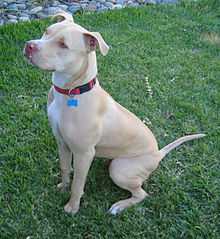 |
| Schnauzer (Miniature) (Group 2, Schnauzer) placed in the Terrier Group by many kennel clubs | Tenterfield Terrier | American Pit Bull Terrier |
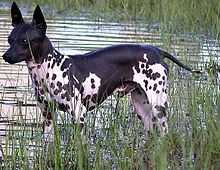 |
|
|
| American Hairless Terrier | Dutch Smoushond (Group 2, Schnauzer) | Patterdale Terrier |
 |
 |
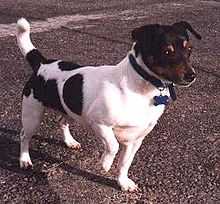 |
| Rat Terrier | Russell Terrier | Teddy Roosevelt Terrier |
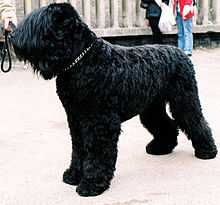 |
 |
.png) |
| Russian Black Terrier (Group 2, Schnauzer) | Boston Terrier (Group 9, Toy) | Danish Swedish Farmdog (Group 2, Pinscher - provisional) |
 |
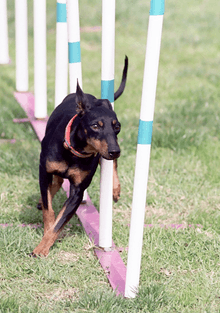 |
 |
| Miniature Fox Terrier | Toy Manchester Terrier | Tibetan Terrier (Group 9, Toy) |
 |
 |
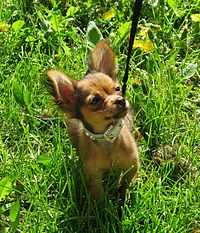 |
| Toy Fox Terrier | Austrian Pinscher (Group 2, Pinscher) | Russkiy Toy (Group 9, Toy - provisional) |
Other clubs
Most kennel clubs in non-English speaking countries include a Terrier Group.
Terriers are also included in the listings of the enormous and ever-expanding number of specialty registries, minor kennel clubs, dog sports clubs, breed clubs, rare dog registries, and internet based dog clubs and businesses. Each will have its own definition of what breeds belong in their own Terrier Group.
Terriers, especially the smaller breeds, have been used for crossbreeding to create what are called designer dogs, bred either accidentally or to enhance the marketability of puppies, often with cute portmanteau names created from syllables of each breed name. Although there are clubs willing to "register" such designer dogs, they are not breeds of dog. Breeders may call designer dogs terriers but they are not part of the Terrier Group of any major kennel club.
The Jack Russell Terrier is notable in that its primary breed club, the Jack Russell Terrier Club of America, specifically regulates inbreeding and linebreeding to a 16% coefficient of relationship. However, it is still a modern purebred dog breed, descended from known ancestors, and crossbred (with another breed of dog) dogs are not registerable.
See also
- Breed Groups (dog)
- Terrier
- FCI Terrier Group
- Pet
- Working terrier
- Companion dog
- Companion Group
References
- ↑ Etymology of Terrier
- ↑ American Kennel Club (2009). "AKC's FSS listing of the Russell Terrier". akc.org. Retrieved 2009-11-13.
- ↑ United Kennel Club (2009). "UKC's Jack Russell Terrier Standard". ukcdogs.com. Retrieved 2009-11-13.
- ↑ Kennel Club Group information:
- ↑ Fédération Cynologique Internationale breed nomenclature




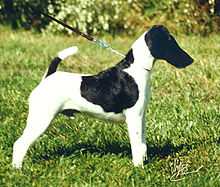
.jpg)
